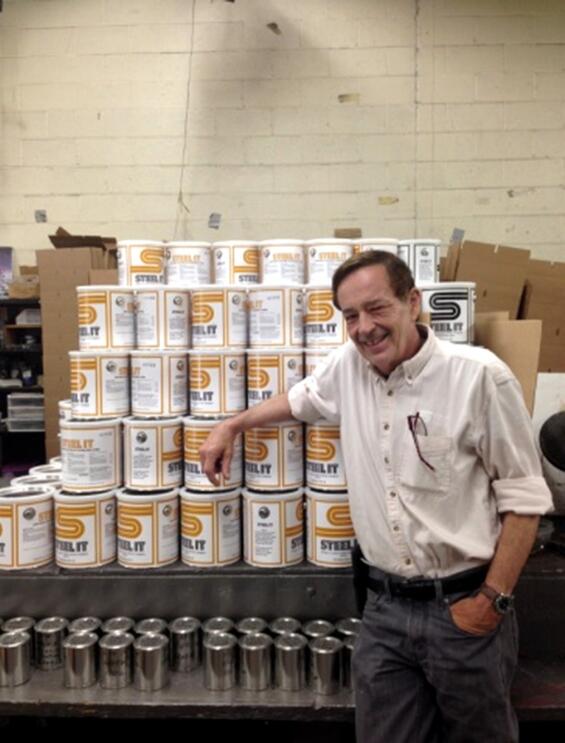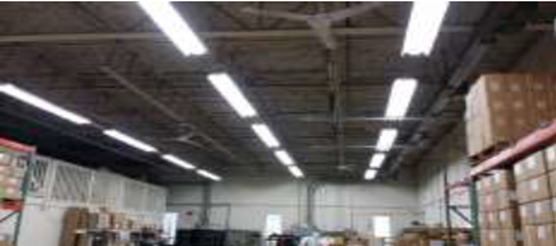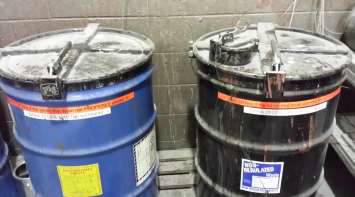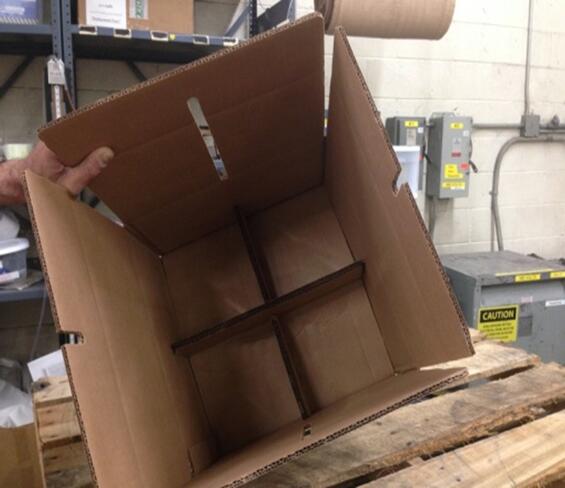Background

Robert Audlee with STEEL-IT
Stainless Steel Coatings, Inc, a manufacturer located in Lancaster, MA, has been in business since 1974. Its flagship product, STEEL-IT, refined by renowned coatings chemist Clive Hare, includes a proprietary, custom-engineered, stainless steel flake that yields a hard, non-toxic metallic finish. The STEEL-IT product line includes coatings targeted for use in different settings where its robust, anti-corrosive properties protect ferrous metals, such as iron and steel, against a range of harsh conditions. USDA-approved for incidental contact with food, STEEL-IT has found a home among food and pharmaceutical manufacturers who use the coating on storage tanks, conveyors, racks, and packaging machinery because they prize the coating’s proven performance against chemicals and food acids, and its ability to withstand high-pressure wash downs common in those industries. Architects and builders specify STEEL-IT for use on structural steel where, in addition to providing an aggressive anti-rust barrier, it protects against ultraviolet rays, sea-spray, and airborne pollutants. Automotive enthusiasts love using STEEL-IT’s high temperature coatings on brake rotors and exhaust system components as much for its performance as for its hip, industrial look.
Over the last few years, Stainless Steel Coatings has made a number of process improvements on their own and with the help of OTA and MassSave. Vice President Robert Audlee has led the effort to find improvements, with extensive collaboration from employees. Michael Faigen, SSC’s president, believes that social responsibility is integral to the company’s business goals, and contributes to increased efficiency and the development of premium products.
Toxics Use Reduction
Beginning in the early 2000s, Stainless Steel Coatings sought ways to reduce volatile organic compounds (VOCs) in their products. TURA reporting drew attention to efficient chemical use and alternatives. First, the company began replacing the amount of xylenes in some of their products with chemicals deemed not to contribute to VOCs as defined by the EPA under the Clean Air Act. The company experimented with a number of formulations and, by 2005, succeeded in removing significant amounts of xylenes from their products by using a new non-photoreactive compound called Oxsol 100 (parachlorobenzotriflouride or PCBTF). Oxsol 100 enables SSC to offer its customers a coating option that is much lower in VOCs and has improved health and safety characteristics, without compromising performance. By comparing the amount of xylenes used in 2013 to the amount that would have been used prior to the reformulation, the company calculated that it reduced its use of xylenes by 57%. Although considerably more expensive than xylene, Oxsol 100 enables SSC to offer its customers a coating option that is much lower in VOCs while not sacrificing STEEL-IT’s established superior performance.
In 2013, SSC began using a new, proprietary magnesium-based product described by Audlee as a “peculiar little molecule,” instead of zinc-bis-triorthophosphate (ZBZ), which contains amounts of hexavalent chromium. This substitution created a higher quality coating that nearly tripled its in-house salt spray corrosion test performance. Although the new chemical is more expensive than ZBZ on a unit basis, SSC was able to reduce its material costs since less of the new chemical is required. The input substitution also eliminated the presence of Higher Hazard Substance hexavalent chromium from the product and facility.
Often SSC uses the same mixing vat to produce different coatings. Each switchover from one product to another requires cleaning the vat with the same solvent used to produce the initial batch. Before improving its production scheduling, batches of paint were typically manufactured as needed leading to frequent product changeovers and gallons of waste solvent from the cleaning process that had to be disposed of, and paid for, as hazardous waste. Working together, paintroom employees recognized the inefficiency of this process and the potential for a better business practice. The new schedule ensures the company makes as many batches in a row as possible thus delaying the need to clean the vat in preparation for making a different formulation. This allows the majority of the cleaning solvent to be saved and used in the production of the next day’s batch instead of being discarded. Implementing this new approach has reduced the company’s annual hazardous waste costs by 52%.
Energy Savings

T-8 ballasts
Through assistance from OTA, Stainless Steel Coatings pursued the MassSave Small and Midsize Business Direct Install Program with National Grid and Prism Energy Services. This included an energy audit of their facility and recommendations for improvements. Based on these recommendations and with help from MassSave to cover the costs, all indoor light bulbs were replaced with either T-8 bulbs and ballasts or compact fluorescent bulbs, occupancy sensors were installed in the offices and restrooms, and the parking lot lights were replaced with LEDs. According to Prism Energy Services, the changes are expected to save 14,500 pounds of CO2 emissions per year. Stainless Steel Coatings predicts a less than two-year pay-back period for the installation costs and a 20-25% reduction in energy costs.
OTA also recommended that SSC develop a plan for assessing and preventing leaks in the facility’s air system. Air leaks can cause as much as 25% of a compressor’s output to be wasted, a loss that is rarely considered. The air compressor and hoses were inspected for leaks and repaired. This process removed approximately 120 hours per year of unnecessary operation time caused by the leaks. Also, SSC installed automatic air-line retractors to prevent further damage to air hoses and increase worker safety. Other measures taken include installing a shutoff valve to the shop air line as well as purchasing KMS Safety Blow Guns to ensure that unrestricted air pressure is regulated to less than 30 psi to ensure compliance with OSHA even in the event of malfunction or operator error.
Stainless Steel Coatings also had the paintroom heater stack relined to reduce its diameter to the optimal size, increase its draft, and improve combustion efficiency.
In total, Stainless Steel Coatings has seen a savings of $120 per month on energy costs as a result of all improvements.
Additional Initiatives

Waste drums with one-handed covers
Following the advice of OTA, the hazardous waste drums were equipped with lids from New Pig Corporation that can be operated with one hand to make it easier for workers to seal them. Also, to prevent solvent evaporation from paint vats while they are filled with raw materials but not in operation, production personnel experimented with different types of covers before deciding on one made of flexible plastic cover.

Cardboard shipping boxes
To reduce recirculation of respirable, possibly combustible dusts within the facility, SSC brought in New England Disposal Technologies to vacuum the overhead trusses and pipes. This improves worker health and safety as well as improving the general appearance of the facility. Seals were replaced in the forklifts to prevent hydraulic fluid leaks. Also, the forklifts were painted to make leak detection easier and improve employee morale by making the equipment aesthetically pleasing. To reduce excess packaging material that ultimately becomes waste, SSC uses specially designed shipping boxes that eliminate the need for a large amount of packaging plastic, foam, and absorbent material.
SSC has also implemented a respirator training program for workers. After attending seminars (including a meeting of the Central Massachusetts Business Environmental Network founded by OTA), the company revamped its respiratory protection plan. The workers had been using NIOSH R95 filters but have switched to NIOSH P100 filters that catch finer particulates. SSC plans to engage an industrial hygienist to measure exposure to solvents in the paintroom in order to identify other improvements to personal protection.
Summary of Results
Total immediate out-of-pocket costs: about $12,000
Projected yearly savings: about $17,000: $15,160 in waste disposal costs, $1,440 in energy costs, and $300 other costs.
- 14,500 lbs of CO2 saved per year
- At least a 57% removal of xylenes
- 100% removal of hexavalent chromium
- 52% less hazardous waste production
Future Plans
Stainless Steel Coatings, through its partnership with OTA, looks forward to developing new formulations to further reduce toxics in their paints and better satisfy customer needs. One plan foresees new products with VOC levels roughly 80% lower compared to existing formulations.

National Wildlife Habitat garden on SSC facility grounds
Management remains committed to involving all employees in decisions that affect them. It believes that a collaborative approach to problem-solving leads to optimal improvements because they are most likely to be implemented. According to Audlee: “In many companies, if management needs to make a change in policies or procedures, there is resistance and sometimes even sabotage from uninvolved, disinterested employees, who feel ‘disconnected’ from the program. We don’t have that problem. We have people jumping in to help, offering suggestions, and working as a group who cares about the outcome.” SSC’s conscientious attitude toward the environment also manifests itself in the portion of company property that has been converted to an official wildlife habitat, providing a sanctuary for birds and a pleasant place for employees to relax.
Stainless Steel Coatings Inc. is proud of its status as a small company that sells to large commercial operations since its inception in the 1970s. SSC sees continued commitment to environmental compliance, energy efficiency, and toxics use reduction as key to realizing its goals.
“When we see something that needs to be improved, we don’t ordinarily think ‘well, this is an environmental improvement,’ or a ‘safety improvement,’ or a ‘cosmetic improvement.’ Most of our changes incorporate an element of each of those. We just think of them all as ‘doing things better.’ From our point of view, every positive change is worth making.”
Published 2015